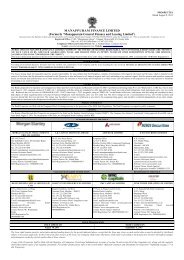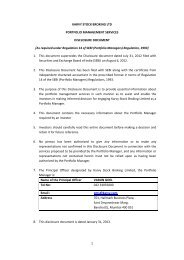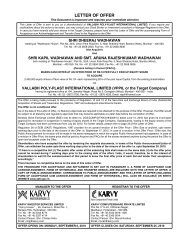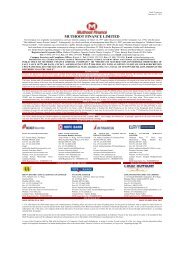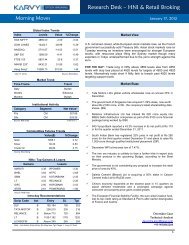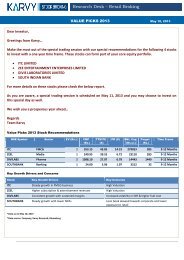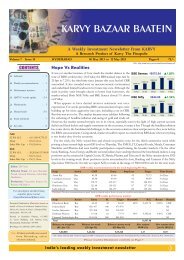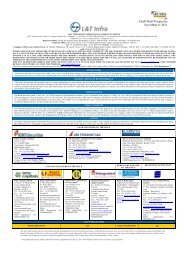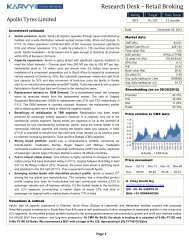APR Constructions Limited - Saffron Capital
APR Constructions Limited - Saffron Capital
APR Constructions Limited - Saffron Capital
You also want an ePaper? Increase the reach of your titles
YUMPU automatically turns print PDFs into web optimized ePapers that Google loves.
Major and Medium irrigation projects mostly comprise dams, canals and lift irrigation schemes. Minor Irrigation<br />
schemes are mainly wells, tube wells, mud canals, etc<br />
(Source: www.mowr.gov.in)<br />
Extension, Renovation & Modernizing (ERM): Typically, ERM schemes aim at avoiding excessive losses in the<br />
distribution system and field channels, a re-appraisal of the irrigation water requirements and frequency of water<br />
application, the conjunctive use of ground water to the extent possible, modifications to canal structures and<br />
construction of new structures as necessary.<br />
Flood Control: Flood Control Schemes aiming to control the damage caused by floods in Food Prone States<br />
(Source: www.planningcommission.gov.in)<br />
Demand<br />
Ultimate irrigation potential which can be created making use of the utilizable surface water resources through major,<br />
medium and minor projects would be about 75.9 m ha. Irrigation potential making use of ground water has now been<br />
assessed as 64 m ha. Thus the total irrigation potential from surface and ground water sources would be about 139.9<br />
m ha. Besides this, an additional irrigation potential of about 35 m ha can be created by taking up long distance inter<br />
basin transfer of water from surplus to deficit basins.(Source: www.cwc.nic.in – Annual Report, 2008 – 09)<br />
State level funding of irrigation projects has been impacted considerably due to the economic slowdown. However,<br />
with a revival in the economy, we expect funding delays to go down.<br />
(Source:CRISIL Research, Indian Infrastructure Report, November 2009)<br />
Supply<br />
In spite of being a sector integral to the growth of Indian agriculture, the irrigation sector continues to be plagued by<br />
issues such as delays in land acquisition and funding constraints at the state level and the lack of interest shown by<br />
state governments in developing this sector. Further, the supply in irrigation had been impacted considerably due to<br />
the recent slowdown in economy as it deteriorated state finance and decelerated the pace of funding of irrigation<br />
projects. However with the revival in the economy, the funding delays are expected to come down.<br />
(Source: CRISIL Research, Indian Infrastructure Report, November 2009 and Planning Commission)<br />
In India, the current Ultimate Irrigation Potential (UIP) is estimated at 139.9 million hectares. Till the end of the<br />
Tenth Five-Year Plan (2002-07), Indian had created irrigation infrastructure of 102.8 mh, leaving a gap of 37.2 mh<br />
(27 per cent) as against the total potential (UIP). As per CRISIL report 10.5 mh of irrigation potential is expected to<br />
be created over Eleventh Five-Year Plan, as against the target of 16 mh laid down by the plan. Further in the next five<br />
year (FY 2010-14) there is an expectation of 15.1 mh of IPC to be created in India.<br />
(Source:CRISIL Research, Indian Infrastructure Report, November 2009)<br />
Major Initiatives<br />
Accelerated Irrigation Benefit Program (AIBP)<br />
The Accelerated Irrigation Benefit Programme (AIBP) was launched during 1996 – 1997 to give loan assistance to<br />
the States to help them complete some of the incomplete major/medium irrigation projects which were at an advanced<br />
stage of completion and to create additional irrigation potential in the country. The State Governments have been<br />
provided an amount of about Rs. 36,534 crores as CLA / Grant under AIBP since inception of this programme till 7 th<br />
81





